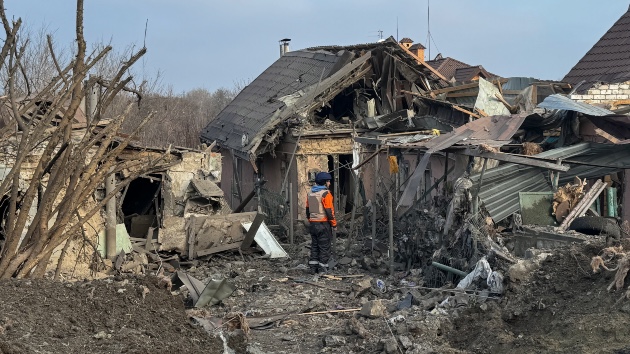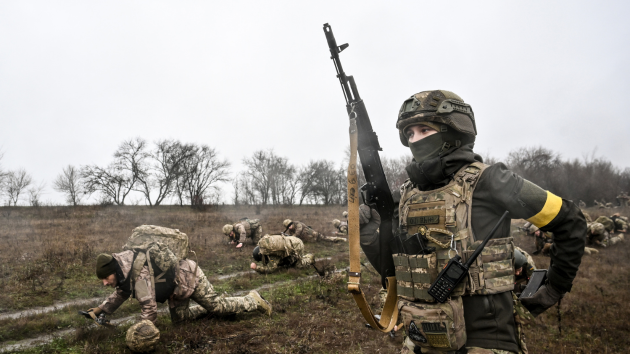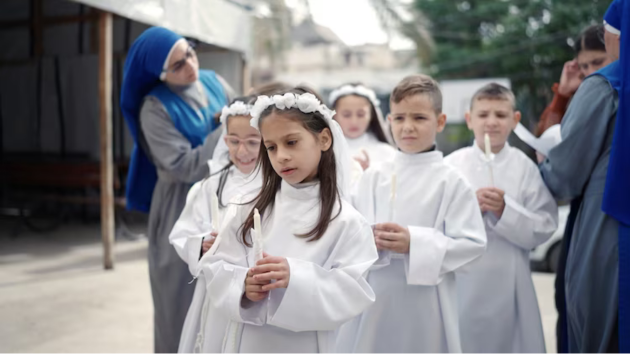From Gaza to US: A teen’s journey from war and amputation to hope
Written by ABC Audio ALL RIGHTS RESERVED on February 5, 2025

Editor’s note: This story contains graphic descriptions of wartime injuries.
(NEW YORK) — A little over a year ago, Motassembelah “Motassem” Abuzayed was a junior in high school, enjoying playing soccer and having barbecues with his friends.
He loved his two pet cats and dreamed of going to college or university to become a successful businessman.
However, those dreams were interrupted when Motassem was severely injured by an airstrike while he was outside with his friends in his neighborhood in the Gaza Strip, he told ABC News. Motassem is one of the more than 25,000 children who have been injured throughout the Israel-Hamas war, according to the United Nations.
Motassem lost most of his left arm in the attack, just a few weeks after the war broke out. His ring finger on his right hand was fully amputated and his middle finger was partially amputated, with attempts made to reconstruct it. He spent months between Gaza and Egypt before he was evacuated to the United States to receive more intensive medical care.
“Everything changed. I had no hope that I would get treatment,” he told ABC News in Arabic. “When I came to America … a future opened for me. I had hope.”
ABC News has been chronicling the journeys of some of the Palestinian children who have been injured over the course of the war.
‘I saw us get hit and then nothing’
Before the war, Motassem lived in the Az-Zawayda neighborhood of northern Gaza with his father, mother and seven siblings: one sister and six brothers.
He was attending school. He said he loved learning, and that geography was his favorite subject.
“I would get up and dressed. I wake up at six [o’clock] in the morning, go to school and learn,” he said. “Then I would go home. I find food ready. I sit with my family, and we eat together. Then I would do my homework, then play soccer with my friends.”
On Oct. 7, 2023, the day Hamas launched a surprise terrorist attack in southern Israel, which resulted in Israel declaring war on Hamas, Motassem said he was asleep.
“We all woke up and all I heard was the sounds of bombs,” he said. “Destruction. You could hear screams on the street. After Oct. 7, there was no joy. They stopped the world.”
Motassem said he and his family originally thought the conflict would be over within a week, but as the war continued, his neighborhood was hit hard. He said his family did not want to leave their home and decided to remain.He said he lived on the same block with his aunts, uncles and cousins, and the family tried to see each other whenever possible.
On the day of his injury, Oct. 28. 2023, Motasaem, then 16, said he was outside, near his house with his cousins and two of his friends when a bomb struck the area around him.
Motasaem does not remember a lot from the day of his injury and the days that followed, which he describes as a mix of memory loss and attempts to block the day from his memory. However, what he does remember is the initial blast.
“That day was a dark day. It wasn’t a normal day,” he said. “I saw us get hit, and after that I saw nothing.”
Motassem said he doesn’t remember anything until he woke up at Al-Aqsa Hospital that he learned he’d lost most of his left arm and two fingers on his right hand.
“I just woke up in the hospital and asked them, ‘What happened?'” he said. “They told me, ‘Your arm is gone.'”
Children wearing scars of the war
Children have been greatly impacted by the Israel-Hamas conflict, with UNICEF Communications Specialist Tess Ingram saying during a briefing last year that kids and teenagers are “disproportionately wearing the scars of the war in Gaza.”
During most of 2024, non-profit Save the Children estimated an average of 475 children were being hurt by explosive weapons each month, or 15 children a day, potentially leaving many with life-long disabilities.
In the same report, doctors from partner organization Medical Aid for Palestinians said children’s wounds are not healing due to increased levels of malnutrition, leading to amputations that would otherwise not be necessary. A senior United Nations official told the Security Council in October 2024 that Gaza is home to the largest number of amputee children in modern history.
Motassem said the pain he felt was “indescribable” and that he felt scared in the hospital. Due to the shortage of medication in Gaza, Motassem said he could only be given Actimol, a drug typically meant to relieve mild to moderate pain and to reduce fever.
Motassem said he had several operations on his arm and fingers and needed to have a chest tube placed on his left side after doctors found he had a hemothorax, which occurs when blood pools in the pleural space, or the space between the lungs and the chest wall.
He also developed a severe bacterial infection, but he said it’s unclear which infection he had.
The journey to get Motassem to the US
Motassem was medically evacuated to Egypt on New Year’s Eve in 2023 through a program run by the Gaza Ministry of Health, according to Tareq Hailat, director of global patient affairs at the Palestine Children’s Relief Fund (PCRF), the NGO responsible for eventually medically evacuating Motassem to the U.S.
“I was happy that I was leaving Gaza to get treatment abroad. When I got to Egypt, I didn’t find the treatment adequate,” Motassem said. “Once I got to the hospital, they kept doing tests on me. They told me I needed some surgeries because of the bone that is coming out [of my arm].”
Motassem’s surgeries in Egypt included a procedure to adjust the shoulder bone in his left arm and to separate fused bones in his right hand, Hailat said. Motassem also suffered from persistent wound infections and doctors removed shrapnel, medical gauze and wooden debris from his wounds.
Hailat said that injured patients evacuated to Egypt are taken to a government facility to be processed. However, because of the overcrowding, patients can go a long time without seeing a doctor or receiving medical care.
Motassem was still suffering from the bacterial infection and still required the chest tube while in Egypt.
“He had extreme pain, obviously, aside from phantom pain, he was having these neuromas of these nerves that were clogging up and creating the severe pain for him,” Hailat said.
A neuroma is a growth of nerve cells that can occur at the end of a severed nerve in an amputated limb. It can be very painful for an amputee.
Because of the pain, physicians were hesitant to give him a prosthetic arm because they were worried it would cause further nerve damage, according to Hailat.
He said medical records show Motassem was in the hospital for two months before it was determined he did not need medical care anymore. His father was able to secure a place to stay for Motassem and his brother, who was accompanying him, according to Hailat.
Hailat said PCRF saw a video on social media in late August 2024 of Motassem first arriving at the hospital in Egypt and, recognizing he needed advanced care, reached out to discuss medically evacuating him to the U.S.
“He was also extremely sad. He was always in his room. He did not leave his room at all to talk to anyone and, when I reached out to him, he actually thought it was a joke at first,” Hailat said. “I reached out and got his father’s number, and I contacted his father, and his father knew that it was serious. I sent them proof of the work that we’ve done.”
“And, at that point, I remember his father picking up the phone and calling me and saying to me, ‘Please make sure that this works, because this child is so severely depressed that if we give him this false hope, then it will shatter him,'” Hailat said. “And, at that moment, I knew that I wanted to make sure that things go right before first contacting Motassembelah and explicitly telling them that he’s going to leave.”
Motassem said he was at the house in Egypt with his brother when he first received the news that he was going to get treatment in the U.S. It had been hard to communicate with his family back home in Gaza due to poor internet connection and he was at a low point mentally.
“It was honestly a miracle from God,” he said. “They reached out to me and said, ‘We want to bring you to America.’ At that point, mentally, I was at a zero in Egypt. When they told me they were bringing me to America, I felt relief.”
“I want to thank Mr. Tareq for the way he treated me,” Motassem said. “When I first got in touch with him in Egypt, he brought the idea of hope back to me and that I will start my future.”
Once Shriners Children’s Hospital in Philadelphia agreed to accept Motassem’s case, Hailat worked to gather the appropriate visas and paperwork needed.
Due to the rules surrounding visas, Motassem would have to go by himself, which his father approved with the PCRF. After several weeks, Motassem became one of the 24 Gazan children PCRF has medically evacuated to the U.S. for treatment.
‘I was at peace’
Motassem was put on a direct flight from Cairo to New York City with another child being medically evacuated to the U.S. It was his first time on a plane, which he described as a “good feeling” but also “tiring.”
Motassem arrived in the U.S. at John F. Kennedy International Airport on his birthday, Oct. 19, 2024. He said he was held up in questioning for four hours and asked if he was a member of Hamas or a supporter of Hamas. Motassem said he doesn’t know any members of the organization.
Photos and videos from that day show a crowd of supporters cheering for Motassem as he arrives, carrying Palestinian flags and welcome signs.
“It was indescribable. I was so happy,” he said. “They were all nice people, and they all welcomed me, it was really exciting. … It was a beautiful day.”
Motassem spent the first day meeting the welcome group and exploring the streets of Philadelphia before his treatment was set to begin at Shriners Children’s Hospital.
When asked to describe what it was like walking around Philadelphia, he said, “I was at peace.”
When Motassem first met with a team at Shriners Children’s, doctors initially believed he just needed a prosthetic device and that his treatment would be finalized within three months, according to Hailat.
However, after the initial physical assessments, the team saw the neuromas and how they were causing severe pain for Motassem.
Doctors said they needed to perform nerve-bundling surgery to reduce his pain and so the prosthetic would fit him in a painless way, and he may need more corrective surgeries, according to Hailat. This entire process may take up to two years.
Because of this increased timeline, Hailat moved Motassem from the host family he was staying with in Delaware to a new home in Greenville, South Carolina.
He currently lives in a house with two teenage boys also from Gaza: Ayham, whose leg was injured during the war, and Ayham’s older brother, Ismail.
“I talk to them every day,” Motassem said. “Those two mean a lot to me. I love them.”
Hailat said it was important to ensure Motassem had people close to his own age with whom he could spend time, especially since no family members are in the U.S. with him.
“One of the things that I was fearful about … now that the medical care plan was going to be so long and we brought him here without a companion, I was scared that he will get very lonely and that he won’t form a community of support,” Hailat said. “And that’s why I brought him to [South Carolina], ensure that he’s with another patient from Gaza, and they are both experiencing very similar medical care plans and could share that that experience with each other, and it’s been absolutely phenomenal. It’s been amazing.”
Motassem said he tries to speak to his family back in Gaza as much as he can.
He said whenever he speaks to his mom, he tries to not talk about his injury and instead discuss future plans.
“I changed the subject. I don’t talk about the injury, anything to do with the injury,” he said. “I try to move past it. … My mother is my whole world. I don’t just miss her food; I miss life with her. She is everything.”
Motassem underwent nerve-bundling surgery on Jan. 24, 2025. In a video diary shared with ABC News after this surgery, he said the surgery went well.
Hopes of returning to Gaza
It’s unclear how long Motassem will need to stay in the U.S. to complete this treatment, but he hopes to return to Gaza one day. The recent ceasefire makes him hopeful.
He compared the day he learned about the ceasefire to the Muslim holiday of Eid, which is the end of the month-long fast of Ramadan.
“I was able to talk to [my family] three days after the ceasefire because there was no internet,” Motassem said. “I told my mom, ‘Congratulations.’ It was like the celebration of a groom’s wedding. The war is over.”
The deal between Israel and Hamas will take place in three different phases, each of which will last for six weeks, according to U.S. and Qatari officials.
Motassem said his family currently lives in a tent in Gaza because half of their house was destroyed over the course of his war. Two of his cousins were killed two days before the ceasefire, he says.
However, he has hope he can return to help rebuild.
“I miss everything in my room. I miss the comfort that I felt while in it,” he said. “This house I was born in and lived my entire life in, and it’s now gone. But 100% we will rebuild.”
He said once his treatment is completed in the U.S., he would like to get a degree in business and give back to the people of Gaza.
“I want to do everything for them, especially after the torture they suffered,” he said. “You don’t even see things like this in movies. The destruction you see in movies is not like what is happening. They deserve to have a right to live. The people of Gaza, the whole world knows who they are now.”
Copyright © 2025, ABC Audio. All rights reserved.





